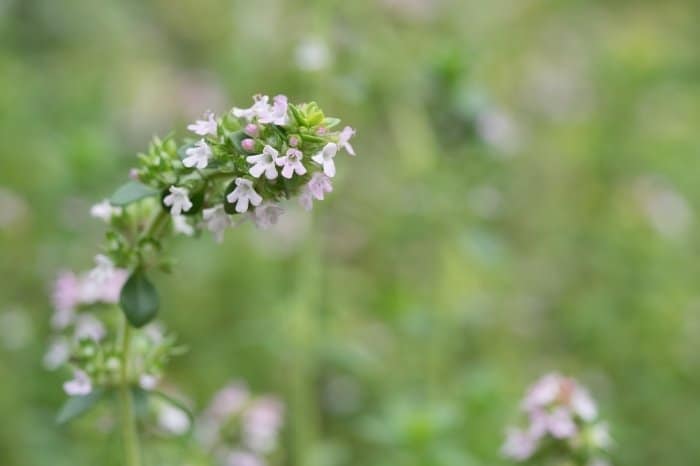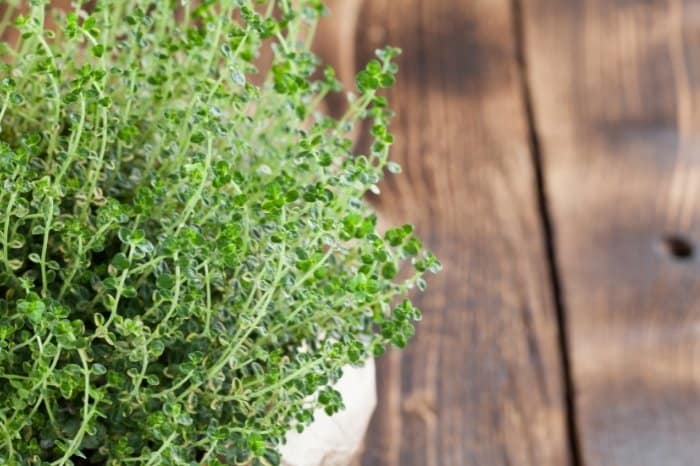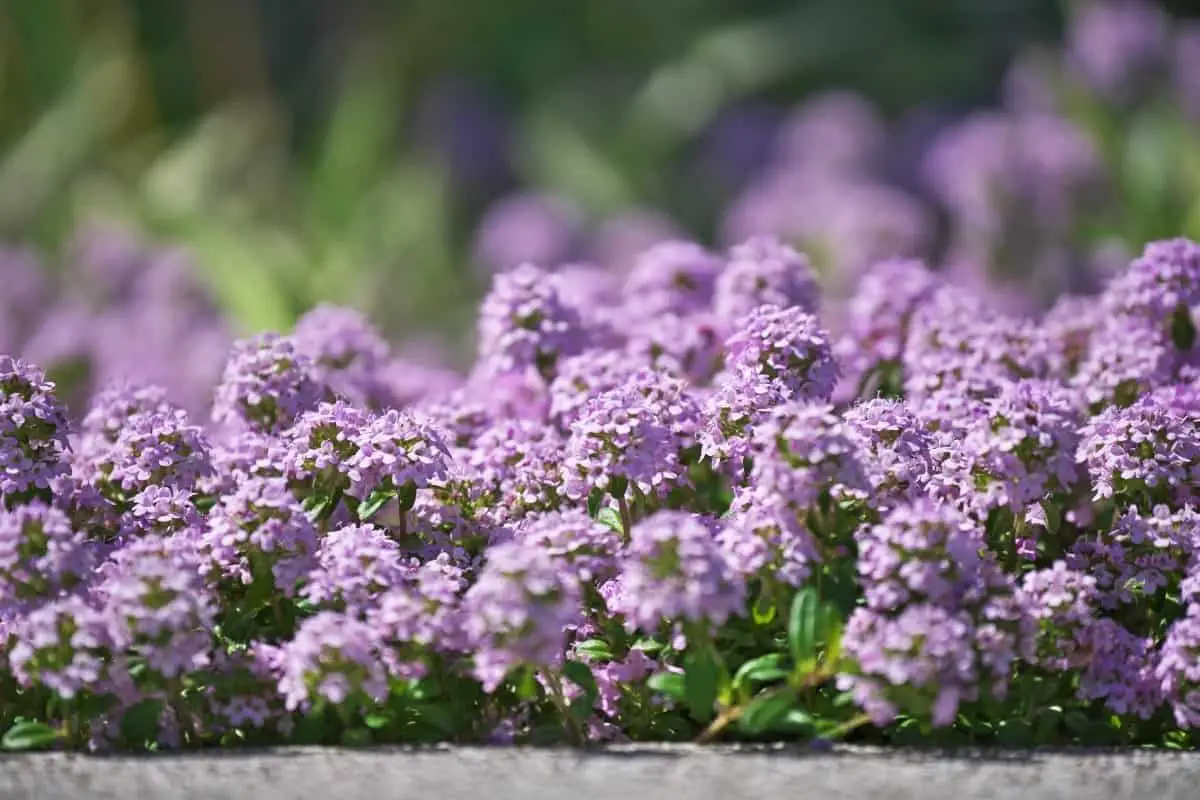Last Updated on March 23, 2022 by Fabiola L.
Is creeping thyme edible, or is it just grown by gardeners because it is an excellent ground cover protecting the soil from too much sun?
The creeping thyme is a woody, perennial species growing horizontally rather than vertically and forms a mat-like ground cover. It is 2 to 3 inches tall with up to 24 inches across.
Although the ordinary thyme grown commercially as a herb is different, creeping thyme is also an aromatic and edible ground cover herb. This hardy plant is commonly loved because it can take some good traffic, making it an excellent choice for pathways and between rock steps.
Is Creeping Thyme Edible?
The creeping thyme is one of the edible ground cover plants popular among gardeners. This herb varies significantly in its culinary usefulness. Their scent and their flavors change with the seasons and the climate of where it grows.
If you plan to harvest the creeping thyme leaves for drying for future use, the best times are to harvest them early and late summer, right before it flowers.
Creeping Thyme Varieties
Before you get creeping thyme for planting from your local nursery, it’s best to know what type of creeping thyme to plant. Let’s dive right in and learn about a variety of creeping thymes.
Thymus Serpyllum
This variety is also known by Breckland thyme, wild thyme, mother of thyme, pink chintz, creeping thyme, or mauve creeping thyme. This type has brighter colored leaves that are purple to lilac or pink.
The Serphyllum blooms between July and August and does well in USDA hardiness zone 4. These plants grow up to 3 inches tall, and the leaves are generally .02 to 0.3 inches with a thickness of 5 dimes. This type grows wild in the rocky soils of North Africa and Southern Europe. While all thymes are known for good nectar that bees love, the Serpyllum is much loved by bees. In Greece, wild thyme honey is a delicacy that is much loved.
Read more about Things You Need to Know About Greece National Flower – Best 6 Tips
Thymus Praecox
Thymus praecox is helpful for cooking and has a scent that resembles oregano. It has several subspecies and cultivars that may not have the flavor that you would expect.
This variety is slightly cold-resistant than the Serphyllum type and blooms from June to September. Its flowers are generally purplish white.
Indoor Herb Garden Starter Kit – Heirloom, Non-GMO Herb Seeds – Basil Thyme Parsley Cilantro Seed
Pink Chintz
Pink Chintz has fuzzy leaves and grows at least 1 to 2 inches tall with salmon-pink flowers in early spring. This variety can spread up to 18 inches wide and is one of the most drought-tolerant varieties. After it flowers, you can trim it slightly back to get rid of spent blooms and maintain a neat appearance.
Wooly Thyme
Formally known as Thymus Lanuginoss, it is classified as praecox subspecies wooly thyme. It is one of the several species of creping thymes that has hairy and wooly leaves. It is native to Southern Europe, grows about 3 inches tall, and spreads from 12 inches to 3 feet.
The plant does not grow off the ground; instead remains a thick short piled carpet. It produces pink flowers blooming from June to July and growing only in zone 5-8 but might need protection in zone 5. The flowers form along the branch and do not send up flower spikes.
Wooly thyme is the least fragrant thyme and least suitable for culinary uses among all the creeping thymes.
Caraway Thyme
This is a species of thyme with a strong caraway scent. Its real name is herba-barona and is native to Corsica, Sardinnia and Majorca. This species of creeping thyme can be used as a substitute for caraway. The leaves of this plant are more elongated than the other varieties.

Depending on the size of your garden, the caraway thyme does not offer that look that many creeping thymes do, and many gardeners desire. It has pale lavender flowers that grow up to 4 inches tall and spread to about 12 inches.
Caraway thyme was traditionally used to season beef barons in England; it was also used with soups and vegetables to complement garlic well.
Thymus Caespititius
Thymus caespititius or Cretan thyme is a low growing, creeping thyme growing up to 4 inches tall and 1 foot wide.
It thrives in far less cold-tolerant places than many of the other varieties. This herb is a native of Portugal, Azores, and Northwest Spain. It does well in zone 7, 9,-11.
Thymus Caespititius flowers from July to August with flowers that range in color from rose to lilac to white. The leaves smell like tangerines and are entirely edible.
Lemon Thyme
Lemon thyme or Thymus x citriodorus is one of the most edible of all creeping thymes. Its leaves are generally eaten raw, and it’s prized for its delicious lemon flavor.
It’s hardy growing only in zone 7 and does not thrive under shade and strong winds. Lemon thyme grows to an average height of 4 inches and spreads to about 12 inches. Its flowers range from a bright yellow to the more common shades of pink and purple. Its bloom appears from July to August. Lemon thyme is an actual species rather than a hybrid or cross.

FAQs
Is all creeping thyme edible?
The creeping thyme is a perennial herb. The creeping thyme, Thymus serpyllum, has been used as a culinary spice since ancient times. It has a strong, sharp, warm-spicy flavor. The leaves of the creeping thyme are long and narrow, with a smooth margin. They grow close together on a thick, branching stem. The flowers are borne in small clusters, like those of thyme.
It is often grown for its aromatic foliage, which can be harvested and dried to make thyme tea.
Can creeping thyme be used as an herb?
Thyme is a herb that has a multitude of uses, some of which are culinary and others medicinal. This means that you can use it in a variety of ways, depending on the purpose you wish to achieve. Thyme has been used for centuries to help with a variety of ailments. The most common use is to make tea or infusions from the leaves, stems and flowers.
You may also find thyme to be an effective way to relieve your cough, as well as being able to help ease sore throats. You will also find that thyme can be used to help with digestive problems such as indigestion. This is one of the many reasons why thyme has become so popular and why it is now regarded as a common kitchen herb.
What type of thyme is best for cooking?
I know that it depends on what you're trying to achieve, but in general we use fresh thyme as much as possible. It has a lovely aniseed flavour and also helps to improve the flavour of many dishes. However, if you need a little more punch than that, we use dried thyme.
I've grown both types and prefer the variegated. The green leaves are more tender and have a sweeter flavor than the purple-leaved variety. I also use the Greek thyme, and I think it's better than the French variety, because it has a stronger flavor.
The flavor of thyme is very dependent on the variety of plant you are using. Most often, it is used for its fresh, clean, and somewhat delicate flavor.
Some people will maintain that there is no difference between thyme varieties, they are all the same species. They are all easy to grow and they all have similar uses.
Does creeping thyme come back every year?
The plant grows slowly, but once established, it will flower year after year. Thyme has a strong citrus smell when you first cut it. This is what gives it its culinary use.
How does creeping thyme grow?
Creeping thyme is a variety of thyme that grows in a clump rather than on the ground. It has a strong, slightly fruity scent, and the leaves are dark green.
It has a long, spreading root and stems that are hairless. It grows about 5 to 8 inches tall. There is also a different species of creeping thyme (Thymus serpyllum) that is much taller, with stems that are hairy all over, and leaves that are deeply lobed.
Conclusion – Is Creeping Thyme Edible?
FAQs
Is all creeping thyme edible?
The creeping thyme is a perennial herb. The creeping thyme, Thymus serpyllum, has been used as a culinary spice since ancient times. It has a strong, sharp, warm-spicy flavor. The leaves of the creeping thyme are long and narrow, with a smooth margin. They grow close together on a thick, branching stem. The flowers are borne in small clusters, like those of thyme.
It is often grown for its aromatic foliage, which can be harvested and dried to make thyme tea.
Can creeping thyme be used as an herb?
Thyme is a herb that has a multitude of uses, some of which are culinary and others medicinal. This means that you can use it in a variety of ways, depending on the purpose you wish to achieve. Thyme has been used for centuries to help with a variety of ailments. The most common use is to make tea or infusions from the leaves, stems and flowers.
You may also find thyme to be an effective way to relieve your cough, as well as being able to help ease sore throats. You will also find that thyme can be used to help with digestive problems such as indigestion. This is one of the many reasons why thyme has become so popular and why it is now regarded as a common kitchen herb.
What type of thyme is best for cooking?
I know that it depends on what you're trying to achieve, but in general we use fresh thyme as much as possible. It has a lovely aniseed flavour and also helps to improve the flavour of many dishes. However, if you need a little more punch than that, we use dried thyme.
I've grown both types and prefer the variegated. The green leaves are more tender and have a sweeter flavor than the purple-leaved variety. I also use the Greek thyme, and I think it's better than the French variety, because it has a stronger flavor.
The flavor of thyme is very dependent on the variety of plant you are using. Most often, it is used for its fresh, clean, and somewhat delicate flavor.
Some people will maintain that there is no difference between thyme varieties, they are all the same species. They are all easy to grow and they all have similar uses.
Does creeping thyme come back every year?
The plant grows slowly, but once established, it will flower year after year. Thyme has a strong citrus smell when you first cut it. This is what gives it its culinary use.
How does creeping thyme grow?
Creeping thyme is a variety of thyme that grows in a clump rather than on the ground. It has a strong, slightly fruity scent, and the leaves are dark green.
It has a long, spreading root and stems that are hairless. It grows about 5 to 8 inches tall. There is also a different species of creeping thyme (Thymus serpyllum) that is much taller, with stems that are hairy all over, and leaves that are deeply lobed.
Like any other thyme variety, the creeping thyme is edible with an aroma and flavor like mint when steeped for teas or tinctures or crushed. To harvest creeping thyme ground cover, remove the leaves from the stems by snipping from the plant and hanging them upside down in a dark, well-aerated place.
You can enjoy it green or dried. Use it as a garnish to flavor vinegar, teas, herbed butter, meat dishes, salads, or soups.
All these creeping thymes make good groundcovers, and you can walk on them. If you intend to use yours in cooking, plant it away from the footpath where you won’t step on it.
The good thing about this thyme is that it’s easy to grow and spread very fat, giving you a good crop within a short time and for a long season. There you go; we can’t wait to hear your success stories as you grow your own and use them in the kitchen.
Have a healthy happy gardening, won’t you?
Caroline is a gardener who loves to get down to the nitty–gritty of gardening. She proudly proclaims herself as a ‘dirt worshipper‘ and can often be found deep in the garden, covered in soil and singing to her plants. As a self–proclaimed ‘plant whisperer‘, Caroline believes that plants need love and attention just like any other living thing, and she loves to give them both. When she‘s not tending to her garden, you can often find her researching the latest gardening trends, or teaching others how to make their gardens thrive



